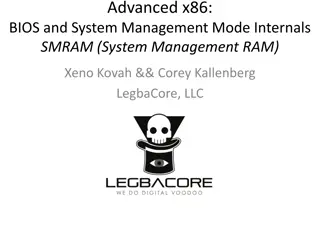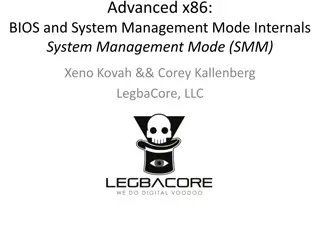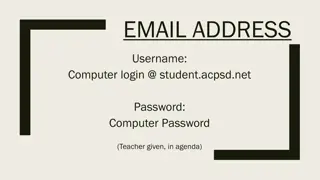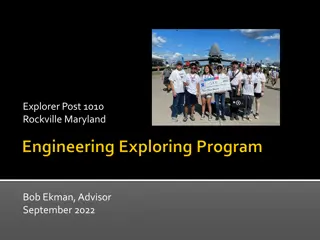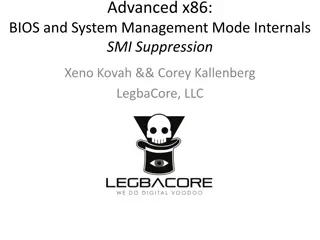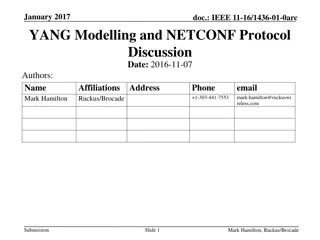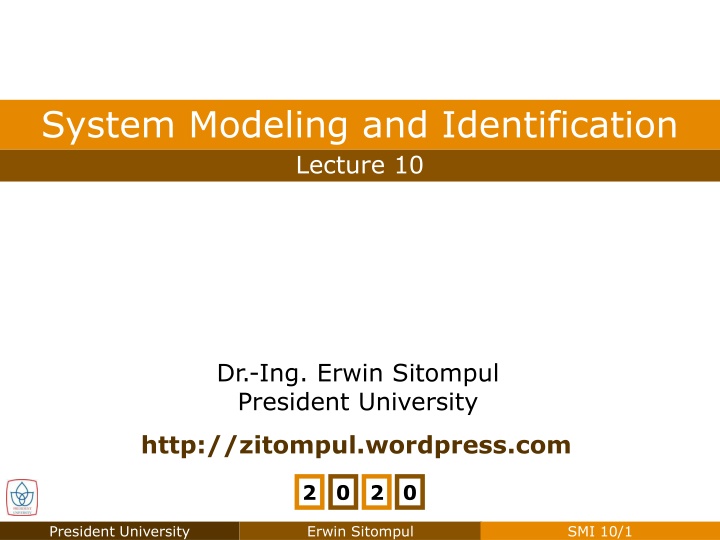
Identification Methods in System Modeling for Academic Success
Explore the process of identifying system models and mastering concepts in system modeling and identification with Dr. Erwin Sitompul at President University. Learn about various identification techniques, including underdamped 2nd order systems, and enhance your understanding through practical examples and solutions.
Download Presentation

Please find below an Image/Link to download the presentation.
The content on the website is provided AS IS for your information and personal use only. It may not be sold, licensed, or shared on other websites without obtaining consent from the author. If you encounter any issues during the download, it is possible that the publisher has removed the file from their server.
You are allowed to download the files provided on this website for personal or commercial use, subject to the condition that they are used lawfully. All files are the property of their respective owners.
The content on the website is provided AS IS for your information and personal use only. It may not be sold, licensed, or shared on other websites without obtaining consent from the author.
E N D
Presentation Transcript
System Modeling and Identification Lecture 10 Dr.-Ing. Erwin Sitompul President University http://zitompul.wordpress.com 2 0 2 0 President University Erwin Sitompul SMI 10/1
Chapter 6 Identification from Step Response Homework 9 Time Percent Value Method Determine the approximation of the model in the last example, if after examining the t/t table, the model order is chosen to be 4 instead of 5. President University Erwin Sitompul SMI 10/2
Chapter 6 Identification from Step Response Solution to Homework 9 5 values of ti/ are to be located for n = 4 t 40 6.7 29 4.8 23.5 3.6 18 2.7 12 1.8 + = = = 6.7 5.97 90 t = = = 4.8 6.04 70 50 t = = = 3.6 6.53 t = = = 2.7 6.67 30 10 t = = = 1.8 6.67 + + + (5.97 6.04 6.53 6.67 6.67) 5 = = 6.38 avg 50 s = ( ) G s Result: t/ Table + 4 (6.38 1) President University Erwin Sitompul SMI 10/3
Chapter 6 Identification from Step Response Solution to Homework 9 Step Response 150 140 130 120 110 100 90 80 70 60 50 40 30 20 10 0 0 5 10 15 20 25 30 35 40 45 50 55 60 65 70 Time (sec) : 5th order approximation : 4th order approximation President University Erwin Sitompul SMI 10/4
Chapter 6 Identification from Step Response Identification of Underdamped 2nd Order System President University Erwin Sitompul SMI 10/5
Chapter 6 Identification from Step Response Identification of Underdamped 2nd Order System President University Erwin Sitompul SMI 10/6
Chapter 6 Identification from Step Response Identification of Underdamped 2nd Order System President University Erwin Sitompul SMI 10/7
Chapter 6 Identification from Step Response Identification of Underdamped 2nd Order System President University Erwin Sitompul SMI 10/8
Chapter 6 Identification from Step Response Identification of Underdamped 2nd Order System President University Erwin Sitompul SMI 10/9
Chapter 6 Identification from Step Response Identification of Underdamped 2nd Order System President University Erwin Sitompul SMI 10/10
Chapter 6 Identification from Step Response Reading: Identification Using Strejc Method President University Erwin Sitompul SMI 10/11
Chapter 6 Identification from Step Response Reading: Identification Using Strejc Method President University Erwin Sitompul SMI 10/12
Chapter 6 Identification from Step Response Reading: Identification Using Strejc Method President University Erwin Sitompul SMI 10/13
Chapter 6 Identification from Step Response Reading: Identification Using Strejc Method President University Erwin Sitompul SMI 10/14
Chapter 6 Identification from Step Response Reading: Identification Using Strejc Method President University Erwin Sitompul SMI 10/15
Chapter 6 Identification from Step Response Reading: Identification Using Strejc Method President University Erwin Sitompul SMI 10/16
Chapter 6 Identification from Step Response Reading: Identification Using Strejc Method ..... President University Erwin Sitompul SMI 10/17
Chapter 6 Least Squares Methods Least Squares Methods The Least Squares Methods are based on the minimization of squares of errors. The errors are defined as the difference between the measured value and the estimated value of the process output, or between y(k) and y(k). There are two version of the methods: batch version and recursive version. ^ President University Erwin Sitompul SMI 10/18
Chapter 6 Least Squares Methods Least Squares Methods Consider the discrete-time transfer function in the form of: 1 1 1 1 1 n a z a z + + + + + m b z b z = ( ) m G z n The aim of Least Squares (LS) Methods is to identify the parameters a1, ..., an, b1, ..., bm from the knowledge of process inputs u(k) and process output y(k). As described by the transfer function above, the relation of process inputs and process outputs is: ( ) ( 1) ( ) n y k a y k a y k n = + + + ( 1) ( ) bu k b u k m 1 1 m President University Erwin Sitompul SMI 10/19
Chapter 6 Least Squares Methods Least Squares Methods This relation can be written in matrix notation as: T ( ) ( ) y k k = m where: T = a a b b Vector of Parameters 1 1 n m T( ) k = m ( 1) ( ) ( 1) ( ) y k y k n Vector of Measured Data u k u k m Hence, the identification problem in this case is how to find based on the actual process output y(k) and the measured data from the past m(k). President University Erwin Sitompul SMI 10/20
Chapter 6 Least Squares Methods Least Squares Methods Assuming that the measurement was done for k times,with the condition k n+m, then k equations can be constructed as: = + + + (1) (0) (1 ) (0) (1 ) y a y a y n bu b u m 1 1 n m = + + + (2) (1) (2 ) (1) (2 ) y a y a y n bu b u m 1 1 n m = + + + ( ) y k ( 1) ( ) ( 1) ( ) a y k a y k n bu k b u k m 1 1 n m or: T m (1) = (1) (2) y y T m (2) M ( ) y k T m ( ) k = Y President University Erwin Sitompul SMI 10/21
Chapter 6 Least Squares Methods Least Squares Methods If M is nonsingular, then the direct solution can be calculated as: 1 = M Y Least Error (LE) Method, Batch Version In this method, error is minimized as a linear function of the parameter vector. The disadvantage of this solution is, that error can be abruptly larger for t > k. President University Erwin Sitompul SMI 10/22
Chapter 6 Least Squares Methods Least Squares Methods A better way to calculate the parameter estimate is to find the parameter set that will minimize the sum of squares of errors between the measured outputs y(k) and the model outputs y(k) = mT(k) ( 1 k = ( ) ( ) = Y M Y M ^ ) i 2 ( ) T = ( ) y k ( ) k J m T T T T T T T = + Y Y Y M M Y M M The extreme of J with respect to is found when: ( ) 0 d dJ President University Erwin Sitompul SMI 10/23
Chapter 6 Least Squares Methods Least Squares Methods The derivation of J( ) with respect to can be calculated as: ( ) J = Y Y Y M M Y T T T T T T + M M ( ) d dJ T T T = + 0 M Y M Y M M 0 2 T T = M Y M M 2 2 ( ) 1 T T = Least Squares (LS) Method, Batch Version M M M Y ( ) ) ( = Ax ) d d d d d d ( ( ) T T T = = = + T T Ax A x A x Ax A A x x x x 2 if A symmetric President University Erwin Sitompul SMI 10/24
Chapter 6 Least Squares Methods Least Squares Methods Performing the Second Derivative Test , ( ) T 0 d ( ) T 2 2 d ( M M dJ T T = + M Y M Y M M 2 2 d J = M M Always positive definite ) 1 T T M Y is a solution that will minimize the squares of errors = Second Derivative Test If f (x) = 0 and f (x) > 0 then f has a local minimum at x If f (x) = 0 and f (x) < 0 then f has a local maximum at x If f (x) = 0 and f (x) = 0 then no conclusion can be drawn President University Erwin Sitompul SMI 10/25
Chapter 6 Least Squares Methods Least Squares Methods In order to guarantee that MTM is invertible, the number of row of M must be at least equal to the number of its column, which is again the number of parameters to be identified. More row of M increase the accuracy of the calculation. In other words, the number of data row does not have to be the same as the sum of the order of numerator and denominator of the model to be identified. If possible, rows with any value assumed to be zero (because no measurement data exist) should not be used. President University Erwin Sitompul SMI 10/26
Chapter 6 Least Squares Methods Example: Least Squares Methods The parameters of a model with the structure of: 2 2 1 1 2 1 2 1 a z a z + + b z = ( ) G z are to be identified out of the following measurement data: 0 1 2 3 4 ( ) 0.5 0.8 0.2 0.8 0.7 ( ) 0 0 1 1.4 0.6 y k 5 6 k 0.8 5.4 0.7 17.2 u k Perform the batch version of the Least Squares Methods to find out a1, a2, and b2. Hint: n + m = 2 + 1 At least 3 measurements must be available/utilized. Hint: If possible, avoid to many zeros due to unavailable data for u(k) = 0 and y(k) = 0, k < 0. President University Erwin Sitompul SMI 10/27
Chapter 6 Least Squares Methods Example: Least Squares Methods Using the least allowable data, from k = 2 to k = 4, the matrices Y and M can be constructed as: (2) (3) (4) 1 1.4 0.6 y y y = = Y T m (2) (1) (2) (3) (0) (1) (2) (0) (1) (2) 0 0 0 0.5 0.8 y y y y y y u u u T = = = M m (3) 1 1.4 1 0.2 T m (4) a a b 1 = 2 0 1 2 3 4 5 6 k ( ) ( ) y k 0.5 0.8 0.2 0 0 0.8 1.4 0.7 0.6 0.8 5.4 0.7 17.2 u k 2 1 President University Erwin Sitompul SMI 10/28
Chapter 6 Least Squares Methods Example: Least Squares Methods 3.56 5.62 3.20 5.62 9.93 5.28 3.20 5.28 ( ) 1 T = M M 4 2.24 0.6 0.5 T = M Y 3 4 2 a a b 1 2 ( ) 2 z z 1 T T = = = = ( ) G z M M M Y 1 2 1 3 + + 1 2 4 z 2 President University Erwin Sitompul SMI 10/29
Chapter 6 Least Squares Methods Homework 10 Redo the example, utilizing as many data as possible. Does your result differ from the result given in the slide? What could be the reason for that? Which result is more accurate? President University Erwin Sitompul SMI 10/30
Chapter 6 Least Squares Methods Homework 10A Redo the example, utilizing least allowable data, if the structure of the model is chosen to be b z G z a z a z + + (7 Older Students) 1 1 b z + = = ( ) ( ) 1 1 G z 2 2 1 2 1 1 1 a z 1 2 1 (6 Younger Students) After you found the three parameters a1, a2, and b1, for G2(z), use Matlab/Simulink to calculate the response of both G1(z) and G2(z) if they are given the sequence of input as given before. 2 ( ) 1 3 4 z z + + ( ) 0.5 0.8 0.2 0.8 0.7 u k 0 1 2 3 4 5 6 k 2 z = G z 1 0.8 0.7 1 2 Compare y(k) from Slide 10/15 with y1(k) and y2(k) from the outputs of the transfer functions G1(z) and G2(z). Give analysis and conclusions. Deadline: One day before the next lecture. President University Erwin Sitompul SMI 10/31
Chapter 6 Least Squares Methods Homework 10B The following response is obtained from the transfer function: 100 ( ) 11.2 41 70 s s s s + + + = G s + 4 3 2 100 You can reproduce the figure by using the given transfer function. Take date from the response and approximate the transfer function with an underdamped second order system. Plot both response at the same figure and compare. Hint: use hold in Matlab. Deadline: One day before the next lecture. President University Erwin Sitompul SMI 10/32
Chapter 3 Dynamic Response FCS Slide: Underdamped 2nd Order System The step response of second-order system in typical form: 2 n = ( ) H s + + 2 2 n 2 s s n is given by: ( ) Y s 2 n 1 s = + + 2 2 n 2 s 1 s s n + s = n n + + + + 2 2 d 2 2 d ( ) ( ) s s n n = =L t t 1 1 cos sin e t e t ( ) y t ( ) Y s n n d d 2 1 = + nt ( ) 1 y t cos sin e t t d d 2 1 President University Erwin Sitompul SMI 10/33
Chapter 3 Dynamic Response FCS Slide: Underdamped 2nd Order System Time domain specification parameters apply for most second-order systems. Exception: overdamped systems, where > 1 (system response similar to first-order system). Desirable response of a second-order system is usually acquired with 0.4 < < 0.8. = + nt ( ) 1 y t cos sin e t t d d 2 1 President University Erwin Sitompul SMI 10/34
Chapter 3 Dynamic Response FCS Slide: Rise Time The step response expression of the second order system is now used to calculate the rise time, tr,0% 100%: = + 0 e or, 2 1 tan 1tan r d n rt ( ) 1 1 r y t cos sin e d r t d r t 2 1 n rt Since , this condition will be fulfilled if: cos 1 = = tan d + = sin 0 d r t d r t 2 = d rt d ( ) = 1 = d t = = n d 2 1 d n tr is a function of d President University Erwin Sitompul SMI 10/35
Chapter 3 Dynamic Response FCS Slide: Settling Time Using the following rule: sin A B + = cos cos( ), C with: A B = + = 2 2 1 , tan C A B The step response expression can be rewritten as: e y t = where: nt ( ) ( ) 1 cos( ) t d 2 1 tsis a function of = 1 tan 2 1 1 = n President University Erwin Sitompul SMI 10/36
Chapter 3 Dynamic Response FCS Slide: Settling Time The time constant of the envelope curves shown previously is 1/ n, so that the settling time corresponding to a certain tolerance band may be measured in term of this time constant. 2.996 s n 4.605 3.912 = = = t t t , 1% , 5% , 2% s s n n President University Erwin Sitompul SMI 10/37
Chapter 3 Dynamic Response FCS Slide: Peak Time When the step response y(t) reaches its maximum value (maximum overshoot), its derivative will be zero: = + nt ( ) 1 y t cos sin e t t d d 2 1 ( ) = + + t cos sin y t e t t n n d d 2 1 t sin cos d e t t n d d d 2 1 2 ( ) = + nt sin n y t e t d d 2 1 President University Erwin Sitompul SMI 10/38
Chapter 3 Dynamic Response FCS Slide: Peak Time At the peak time, 2 n pt ( ) p y t = + sin n e d p t 0 d 2 1 0 = 0, ,2 ,3 , d pt Since the peak time corresponds to the first peak overshoot, = t p d tp is a function of d President University Erwin Sitompul SMI 10/39
Chapter 3 Dynamic Response FCS Slide: Maximum Overshoot Substituting the value of tp into the expression for y(t), = + = + n pt ( ) 1 p y t cos sin e d p t d p t 2 1 2 1 e = + 1 ( ) 1 p y t cos sin e n d 2 1 ( ) ( ) p y t y = = ( ) % 100% M ( ) p y t + M y p p ( ) y 2 = ) 1 1 (1 e 2 = 1 % 100% M e p 2 = 1 M e if y( ) = 1 p President University Erwin Sitompul SMI 10/40

